#Gabriel Gómez
Explore tagged Tumblr posts
Text
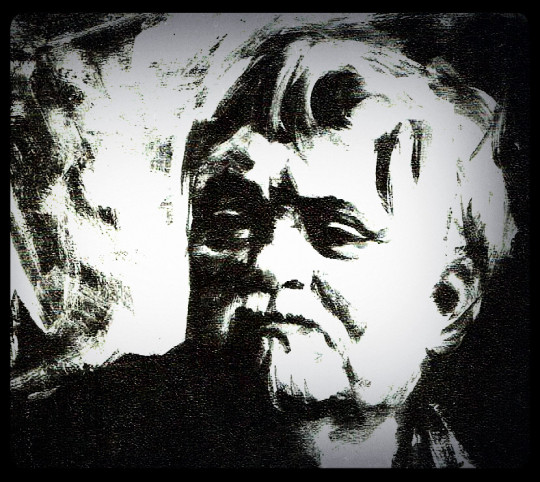
«Quizás no hay error más funesto que el que consiste en concebir el yo como el reducto o la guarida de la originalidad. Para comprenderlo mejor hay que hacer intervenir aquí la noción injustamente desacreditada de los dones. Lo mejor de mí no me pertenece, no soy en absoluto su propietario, sino sólo depositario. No tiene ningún sentido preguntarse, a no ser en un registro metafísico que actualmente ya no es el nuestro, de dónde vienen estos dones, cuál es su procedencia. Por el contrario, lo que importa de entrada es saber qué actitud adoptaré ante ellos. Si los miro como un depósito que estoy obligado a hacer fructificar, es decir, en el fondo como la expresión de una llamada que me ha sido dirigida, o incluso a veces como la expresión de una cuestión que se me ha planteado, no pensaré en enorgullecerme por ello y en pavonearme delante de otros, es decir, de nuevo ante mí mismo.»
Gabriel Marcel: «Yo y el otro», en Homo viator. Editorial Sígueme, pág. 31. Salamanca, 2005.
TGO
@bocadosdefilosofia
@dias-de-la-ira-1
#marcel#gabriel marcel#homo viator#yo y el otro#existencialismo#filosofía conemporánea#originalidad#don#dones#yo#teo gómez otero
5 notes
·
View notes
Text
PAN Veracruz contra robo de ahorros
Para Acción Nacional, el “Dictamen de las Comisiones Unidas de Vivienda y de Trabajo y Previsión Social respecto de la minuta con proyecto de decreto por el que se reforman, adicionan y derogan diversas disposiciones de la Ley del Instituto del Fondo Nacional de la Vivienda para los Trabajadores y de la Ley Federal del Trabajo, en materia de Vivienda con orientación social” representa un atraco a…
#Alicia Lara Gómez#Ana Cristina Ledezma López#Andrea Vanesa Martínez Galicia#Arian Gabriel Hernández#CDEPAN#Claudia Quiñones Garrido#Cristina Pérez Silva#DeOficio#Enrique Ruiz Ruiz#Gabriel Medardo López García#Jose Ramón Téllez Juárez#Partidista#Veracruz
0 notes
Text
Probablemente, si usted pregunta en el medio radial por Juan Manuel Gómez, pocos van a saberle responder; pero si pregunta por "El Pecoso" de Pereira, hasta los oyentes de radio le van a responder con admiración y propiedad. Esta es la conversación con uno de los personajes más admirados y queridos de la radio regional colombiana, una de mis personas favoritas en el mundo. Es un tipo que oye, respira, sueña y hace radio. Y como ya no quedan muchos iluminados por la mística del transistor, comparto este episodio para el que Armando Plata Camacho, decano de los DJs en Colombia, hace la introducción.
1 note
·
View note
Text
Exposición "Hijos de Darwin", Colectiva

View On WordPress
#2023#Adrián Fernández#Alejandro Gómez Cangas#Alex Hernández#Alfredo Sarabio Jr.#Ariamna Contino#Daniel Rodríguez Collazo#Gabriel Ra��l Cisneros Báez#Gerardo Liranza Durán#Jorge Otero#Lisandra Ramírez#Mabel Poblet#Muestra Colectiva#Rafael Villares#Roldán Lauzán#Salón Blanco#William Acosta#Yohy Suárez
0 notes
Text

Nazgûl by Gabriel Gómez Almenzar
846 notes
·
View notes
Text

Libros/Arte: Handmade Books from Latin America & the Caribbean / Libros hechos a mano de Latinoamérica y el Caribe, (brochure), Edited by Elizabeth Floyd Mair, Translation by Néstor Pastor, Design/Photography by Gil Gentile, University Art Museum, University at Albany, State University of New York, Albany, NY, 2023 (pdf here)
Cover Image: Patria, 2021, illustrated book of 28 texts, linocuts and collagraphs on handmade paper; Authors: Bonifacio Byrne, Rafaela Chacón Nardi, Gabriel de la Concepción Valdés, Roberto Fernández Retamar, Sindo Garay, Gertrudis Gómez de Avellaneda, Nicolás Guillén, José María Heredia y Heredia, Pedro (Perucho) Figueredo Cisneros, Carlos Manuel de Céspedes, Juan Cristóbal Nápoles Fajardo, Manuel Navarro Luna, Noel Nicola, Silvio Rodríguez; Illustrator/Designer: José Emilio Leyva Azze; Artistic Realization: Boris Angel Dorrego Bergantiño, Yanely Esquijarosa Abradelo; Collaborator: Fabio Ochoa Cuba; Editor: Manuel Arias Silveira; Printer: Rubén Darío Zaldivar Santiesteban; Publisher/Location: Casa Editora Cuadernos Papiro, Holguíno
Exhibition: August 7 – December 4, 2023 presented in partnership with the University at Albany M.E. Grenander Special Collections and Archives; the Department of Languages, Literatures, and Cultures; and the Department of Latin American, Caribbean, and U.S. Latino Studies










#graphic design#art#exhibition#brochure#book#cover#book cover#elizabeth floyd mair#néstor pastor#gil gentile#university at albany art museum#2020s
29 notes
·
View notes
Text

Marisa Paredes
Spanish star of films by Pedro Almodóvar, Guillermo del Toro and Roberto Benigni, and a champion of leftwing causes
The actor Marisa Paredes, who has died suddenly aged 78, was renowned for her elegance and “calm grace, that gentle cheerfulness that she ignited with one look of her pale eyes”, in the words of Gilles Jacob, former president of the Cannes film festival. She is best known for her roles in six films directed by Pedro Almodóvar.
After seeing her in a play, Almodóvar cast her as Sor Estiércol (Sister Manure) in Entre Tinieblas (Dark Habits, 1983). Later, she starred in his surreal melodrama Tacones Lejanos (High Heels, 1991). For her performance as a writer of romantic novels in his slightly more sober La Flor de Mi Secreto (The Flower of My Secret, 1995), she was nominated for a Goya best actress award. She also featured in Almodóvar’s Oscar-winning Todo Sobre Mi Madre (All About My Mother, 1999).
She became one of Spanish cinema’s great figures, but was also outspoken throughout her life in support of leftwing causes. As president of Spain’s film academy from 2000 to 2003, she attacked the participation of José María Aznar’s Conservative government in the planned invasion of Iraq. Her televised speech at the annual Goya awards in 2003 helped mobilise mass demonstrations: “There is no need to be afraid of culture, entertainment or freedom of expression, and much less satire or humour. We should be afraid of ignorance and dogmatism. We should be afraid of war.”
In the 1980s Paredes built a solid reputation in Spanish cinema, working with up-and-coming young directors, such as Fernando Trueba in Ópera Prima (Debut, 1980), Jaime Chávarri, Jaime Rosales and Agustí Vilaronga in Tras el Cristal (In a Glass Cage, 1986). Her performance in Vilaronga’s macabre anti-Nazi film was her own favourite. For José Sacristán’s comedy Cara de Acelga (Like Death Warmed Up, 1987) she was nominated for a Goya as best supporting actress.
In the 90s, her leading parts in Almodóvar films broadened her career into international cinema. She worked with Alain Tanner in France, Manoel de Oliveira in Portugal and shot two films with the Mexican Arturo Ripstein: Pintura Carmesí (Deep Crimson, 1996) and El Coronel No Tiene Quien le Escriba (No One Writes to the Colonel, 1999), a successful adaptation of a Gabriel García Márquez novel. She was in the Italian Roberto Benigni’s La Vita è Bella (Life Is Beautiful, 1997) and Guillermo del Toro’s El Espinazo del Diablo (The Devil’s Backbone, 2001). Over her six-decade career, she acted in more than 70 films.
The youngest of four daughters, Marisa was born in Madrid, in the block of flats on Plaza de Santa Ana where her mother, Petra (nee Bartolomé), was the concierge. Her father, Lucio Paredes, worked in the El Águila beer factory. These were years of hunger after the civil war (1936-39) and her family was poor. From the age of six, she told her mother she wanted to be an actor: the Teatro Español, one of the city’s main theatres, just across the square from her home, inspired her. Reasonably, her parents opposed this insecure career: they aspired for her to become a secretary. Paredes was always proud of her working-class origins. “My elegance comes from my grandfather, who was a farm-worker,” she would say.
Focused on her ambition, she left school aged 11, defeated parental opposition to study at the Madrid dramatic arts school and pushed her way into small film roles at the age of 14. In 1962 she met Fernando Fernán-Gómez, anarchist and brilliant actor and director, who helped mould both her acting and her view of the world. She acted in his film El Mundo Sigue (The World Continues, 1965).
In the 60s and 70s she worked in many films without breaking through to leading roles. The story was different on Televisión Española, where she acted in around 80 plays, often dramatisations of novels. “I had the good fortune that, as I don’t look Spanish ... when television was cultured and broadcast plays, I was in all the dramas of Chekhov, Dostoevsky, Ibsen. I was the Russian soul,” Paredes explained. She was an all-round talent, acting not just in theatre and highbrow TV, but in musicals, comedies and even a spaghetti western.
With her height, aristocratic bearing and blond hair, Paredes was reminiscent of a classic Hollywood star. Yet she was not vain: she had a warm smile and generous nature, and had the enthralling gift of great screen actors of expressing emotion with a single look or grimace.
She won prizes for her theatre, television and film work, and an honorary Goya for her career in 2018.
Paredes supported #MeToo vigorously and campaigned in the July 2023 general election for Sumar, the junior leftwing partner in Spain’s coalition government. As recently as 30 November, she read the manifesto in a demonstration against Israel’s actions in Gaza. She understood her political commitment in no narrow terms: “Freedom, education and culture are fundamental to human life. This is what remains. Art is what remains.”
Paredes had a daughter, María, with the film director Antonio Isasi-Isasmendi in 1975. From 1980 until her death she lived with José María Prado, director for 27 years of the Filmoteca Española (Spain’s film institute). She did not believe in marriage.
Prado and María survive her.
🔔 Marisa (María Luisa) Paredes Bartolomé, actor, born 3 April 1946; died 17 December 2024
14 notes
·
View notes
Text
La Violencia (Research I did for Encanto fic writers so you don't have to)
TW: Assassination and death
Long but necessary post
@yellowcry @miracles-and-butterflies @evostar (if you already knew about it, that's fine, but reblog so others can too.)
To put it simply;
During this time, an estimated 200,000 people lost their lives, with 112,000 of those deaths occurring between 1948 and 1950. Additionally, two million people were forcibly displaced from their homes, primarily to Venezuela.
The root of this conflict lies in the intense partisan rivalries between Colombia’s two traditional political parties: the Liberal Party and the Conservative Party. These tensions created a divide between liberals and conservatives, eventually leading to the partial collapse of the state and existing institutional structures. As violence escalated, economic motivations began to outweigh political ones, and armed bands took advantage of the chaos to commit robberies, assaults, and revenge against their neighbors.
More in depth;
La Violencia was a ten-year civil war in Colombia from 1948 to 1958, between the Colombian Conservative Party and the Colombian Liberal Party, fought mainly in the countryside.
Liberal hegemony continued through the 1930s and the World War II era, and Alfonso López Pumarejo was reelected in 1942; however, wartime conditions were not favourable to social change. In the elections of 1946, two Liberal candidates, Gabriel Turbay and Jorge Eliécer Gaitán, stood for election and thus split the Liberal vote. A Conservative, Mariano Ospina Pérez, took office.
Conservatives had been embittered by political sidelining and, since 1930, had suffered violent attacks at the hands of Liberal supporters. With the electoral victory of 1946 they instituted a series of crude reprisals against Liberals. It was the initiation of the period that was dubbed La Violencia. On April 9, 1948, Gaitán, leader of the left wing of the Liberal Party, was assassinated in broad daylight in downtown Bogotá. The resulting riot and property damage (estimated at $570 million throughout the country) came to be called the bogotazo.
La Violencia originated in an intense political feud between Liberals and Conservatives and had little to do with class conflict, foreign ideologies, or other matters outside Colombia. Authoritative sources estimate that more than 200,000 persons lost their lives in the period between 1946 and 1964.
The most spectacular aspect of the violence, however, was the extreme cruelty perpetrated on the victims, which has been a topic of continuing study for Colombians. La Violencia intensified under the regime of Laureano Gómez (1950–53), who attempted to introduce a fascist state. His excesses brought his downfall by military coup—Colombia’s first in the 20th century. Gen. Gustavo Rojas Pinilla assumed the presidency in 1953 and, aided by his daughter, María Eugenia Rojas, began an effort to end La Violencia and to stimulate the economy.
Rojas was a populist leader who supported citizens’ demands for the redress of grievances against the elite. Support for Rojas began to collapse when it appeared that he would not be able to fulfill his promises, when he showed reluctance to give up power, and when the economy faltered as a result of a disastrous fall in coffee prices in 1957. He was driven from office that year by a military junta.
The arrangement for the National Front government—a coalition of Conservatives and Liberals—was made by Alberto Lleras Camargo, representing the Liberals, and Laureano Gómez, leader of the Conservative Party, in the Declaration of Sitges (1957).
The unique agreement provided for alternation of Conservatives and Liberals in the presidency, an equal sharing of ministerial and other government posts, and equal representation on all executive and legislative bodies. The agreement was to remain in force for 16 years—equivalent to four presidential terms, two each for Conservatives and Liberals. The question of what governmental structure would follow the National Front was left unsettled.
It had been contemplated that a Conservative would be the first to occupy the presidency in 1958. When the Conservative Party could not agree on a candidate, however, the National Front selected Lleras, who had previously served in that office for 12 months in 1945–46.
During Lleras’s tenure an agrarian reform law was brought into effect, national economic planning for development began, and Colombia became the showcase of the Alliance for Progress (a U.S. attempt to further economic development in Latin America). But severe economic difficulties caused by low coffee prices, domestic unemployment, and the apparent end of the effectiveness of import substitution were only partially offset by Alliance aid.
The Alliance increased Colombia’s economic dependence on the United States, which, to some Colombians, had serious disadvantages. By 1962 economic growth had come almost to a standstill.
The precarious state of the economy and the degree of social tension were revealed when only about half of those eligible to vote did so in the 1962 presidential elections, which brought Guillermo León Valencia, a Conservative, to the presidency.
During Valencia’s first year in office internal political pressures led to devaluation of the peso (Colombia’s currency), wage increases among unionized workers of some 40 percent, and the most rampant inflation since 1905. Extreme deflationary policies were applied in the next three years, raising the unemployment rates above 10 percent in the major cities and turning even more Colombians against the National Front.
Less than 40 percent of the electorate went to the polls in the 1964 congressional elections.
Marxist guerrilla groups began appearing in Colombia during Valencia’s presidency. The first was the National Liberation Army (Ejército de Liberación Nacional; ELN), which was created by a group of Colombian students who had studied in Cuba.
Founded in 1964, the ELN followed strategies espoused by Che Guevara. Another guerrilla group, which followed two years later, was the Colombian Revolutionary Armed Forces (Fuerzas Armadas Revolucionarias de Colombia; FARC), which was more connected to Soviet-influenced communist movements. Much of FARC originated in the “resistance committees” that had appeared in Colombia during La Violencia.
Carlos Lleras Restrepo was the third National Front president (1966–70). He returned the economy to a sound footing, improved government planning for economic development, and pushed through political reforms essential to an orderly end to the Front (which seemed increasingly to constitute a monopoly of power by the Conservative-Liberal oligarchy).
Although the constitutional reform of 1968 stipulated that elections would become competitive again after 1974, the president was still required to give “adequate and equitable” representation to the second largest political party in his cabinet and in the filling of other bureaucratic posts.
Read more here (This article is mostly where I got my info from as well as copilot.ai. I know, AI is bad, but please don't judge me. I was not about to do six hours of research when I have a tool that can help me in seconds.)
What does this have to do with the madrigals?
Well, if you're planning on writing any madrigal (or all) outside of Encanto, La violencia is something you need to take into consideration. It's an important part of Colombia's culture and shouldn't be ignored.
(I just learned about it recently and in turn, need to rewrite some stuff. So I can only imagine that half of the Encanto fandom knows nothing about it)
What cities were safe you ask? I don't think there really was any.
Bogotá: As the capital of Colombia, Bogotá witnessed significant unrest during this period. Political factions clashed, leading to violence and instability.
Cali: Cali, located in the southwestern part of the country, also suffered from La Violencia. It was a hotspot for clashes between Liberal and Conservative supporters.
Medellín: Medellín, another major city, faced its share of violence. The conflict often played out in the streets, affecting civilians and communities.
Barranquilla: This coastal city experienced tensions between rival political groups, resulting in bloodshed and loss of life.
Cartagena: Cartagena, known for its historical significance, was not immune to the violence. The struggle between Liberals and Conservatives left scars on its urban landscape.
Cúcuta: Located near the border with Venezuela, Cúcuta also witnessed violence during La Violencia.
Palmira, Santa Marta, Soledad Atlántico, Armenia, Pereira, Neiva, Valledupar, Bucaramanga, Popayán, Villavicencio, and Soacha were other cities affected by the turmoil.
So, in either city, the madrigals would be exposed to this war if they chose to come out. Now, let's say Encanto is in the very center of Colombia (or at lease close to it) -

(Right where the red dot is)
The closest area is Villavicencio, Puerto Lypez, and Bogota. All three cities that were affected by the war. And I'm not saying Villavicencio is THAT close to Encanto, probably a week trip at best, but still.
Why did I choose the center of Colombia?
Because I don't see it sitting anywhere else. And it's convenient fic wise. But you can do what you want.
Now I'm not saying the Madrigals won't experience fun in the new world. They most certainly will (culture and technology wise), but the war is really unavoidable for them.
That's all for now, but if you have anything to add or for me to correct, reblog or message me.
#Encanto#encanto fanfic#mirabel madrigal#luisa madrigal#isabela madrigal#julieta madrigal#agustin madrigal#alma madrigal#bruno madrigal#antonio madrigal#camilo madrigal#dolores madrigal#pepa madrigal#felix madrigal
51 notes
·
View notes
Text
🪸KVOTHES’ BEST OF 2023🪸
in no particular order, except that i tried to list things that came out this year/last year first <3
poetry
almost obscene, raúl gómez jattin
master, simon shieh
the book, mary ruefle
judas goat, gabrielle bates
please make me pretty, i don’t want to die, tawanda mulalu
ballast, quenton baker
all the flowers kneeling, paul tran
fiction
mrs. s, k. patrick
annihilation, jeff vandermeer
the name of the rose, umberto eco
nonfiction
patricia highsmith: her diaries and notebooks 1941–1995, ed. anna von planta
it was vulgar and it was beautiful: how aids activists used art to fight a pandemic, jack lowery
the eyes of the skin: architecture and the senses, juhani pallasmaa
movies
asteroid city dir. wes anderson
poor things dir. yorgos lanthimos
killers of the flower moon dir. martin scorsese
oppenheimer dir. christopher nolan
stop making sense dir. jonathan demme (1984)
days of heaven dir. terrence malik (1978)
they live by night dir. nicholas ray (1948)
38 notes
·
View notes
Text
Camp Camp Spanish dub
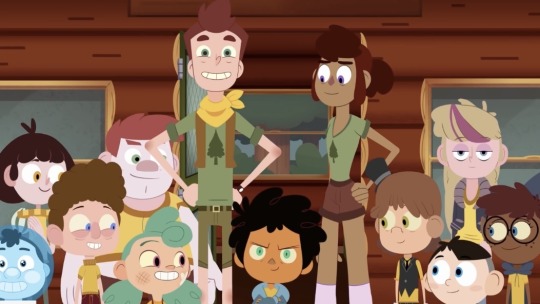
Max: Héctor Emmanuel Gómez
Nikki: Lileana Chacón
Neil: Pascual Meza
David: Irwin Daayán
Gwen: Alondra Hidalgo
Neil “Niño Espacial” Armstrong Jr.: Monserrat Mendoza
Dolph Houston: Arturo Cataño
Harrison: Moisés Iván Mora
Nerris: Nycolle González
Ered Miller: Karen Vallejo
Nurf Nurfington: Raúl Anaya
Preston Goodplay: Óscar Flores
Intendente: Germán Fabregat
Cameron Campbell: Octavio Rojas
Sasha / Erin / Tabii: Carla Castañeda
Edward Pikeman: Jesús Guzmán
Billy “Serpiente” Nikssilp: Alan Fernando Velázquez
Stephan van Petrol: Juan Carlos Tinoco
Hecdor Repugnante: Eduardo Garza
Jasper: Arturo Castañeda
Bonquisha: Laura Torres
Daniel: Alan Bravo
Jen: Karla Falcón
Intenhermana: Gabriela Guzmán
Penelope Priss: Ruth Toscano
Candy: Violeta Isfel (Startalent)
Carl: Andrés López (Startalent)
Agentes Miller: Joaquín Cosio (Startalent)
Sra. Nurfington: Kate del Castillo (Startalent)
El Papá de Nerris: Kuno Becker (Startalent)
La Mamá de Harrison: Consuelo Duval (Startalent)
El Papá de Harrison: Javier Ibarreche (Startalent)
La Mamá de Nerris: Jacqueline Bracamontes (Startalent)
Teniente Stuart Houston: Salvador Cienfuegos (Startalent)
Buzz Aldrin: Rodolfo Neri Vela (Startalent)
La Abuelita de Preston: Elena Poniatowska Amor (Startalent)
Sr. Repugnante: Faisy (Startalent)
Sra. Repugnante: Favio Posca (Startalent)
Brian: Daniel Lacy
Vera: Alicia Barragán
Hwan: Pepe Vilchis
Dang: Miguel Ángel Ruiz
Clark Campwell: Gabriel Pingarrón
Muriel Campwell: Olga Hnidey
Ainsley: Alina Galindo
Louis: César Filio
Cameron Jr.: Ricardo Brust
#camp camp#cc max#cc nikki#cc neil#cc david#cc gwen#cc space kid#dolph houston#cc harrison#cc nerris#ered miller#nurf nurfington#preston goodplay#quartermaster#cameron campbell#cc sasha#cc erin#cc tabii#edward pikeman#cc snake#stephan van petrol#jermy fartz#cc platypus
8 notes
·
View notes
Text

«Pero aquí se impone una advertencia capital. Por el hecho mismo de que el otro no es tratado por mí más que como una caja de resonancia o un amplificador, tiende a convertirse para mí en una especie de aparato que puedo o creo poder manipular, o del que puedo disponer; me formo una idea de él y, cosa extraña, esta idea puede convertirse en un simulacro, en un sustituto del otro, al cual me veré llevado a referir mis actos, mis palabras. Posar, en el fondo, es siempre posar ante uno mismo. «Posar para la galería», se dice familiarmente, pero la galería sigo siendo yo.»
Gabriel Marcel: «Yo y el otro», en Homo viator. Editorial Sígueme, págs. 29-30. Salamanca, 2005.
TGO
@bocadosdefilosofia
@dias-de-la-ira-1
#marcel#gabriel marcel#homo viator#yo y el otro#existencialismo#filosofía contemporánea#pose#imagen#el otro#otro#yo#caja de resonancia#posar#simulacro#manipulación#teo gómez otero
2 notes
·
View notes
Text
2023 in 12 movies (1 per months)
January
The Horse Whisperer (1998) directed by Robert Redford with Robert Redford, Kristin Scott Thomas, Scarlett Johansson, Sam Neil, Chris Cooper and Cherry Jones
[First Time]
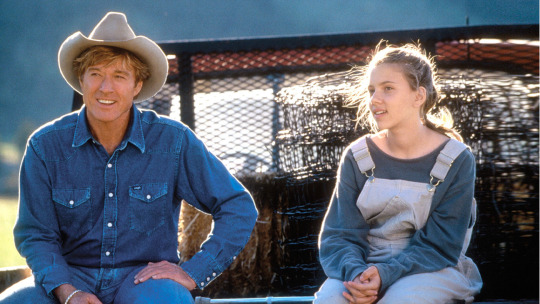
February
L'Horloger de Saint-Paul (1974) directed by Bertrand Tavernier with Philippe Noiret, Jean Rochefort, Jacques Denis, Yves Afonso, Julien Bertheau and Jacques Hilling
[First Time]

March
The Fabelmans (2022) directed by Steven Spielberg with Gabriel LaBelle, Michelle Williams, Paul Dano, Seth Rogen, Keeley Karsten, Julia Butters and Judd Hirsch
[First Time]
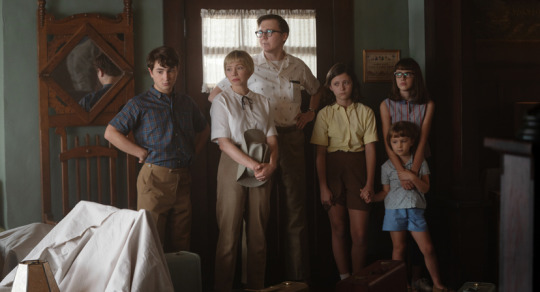
April
The Third Man (1949) directed by Carol Reed with Joseph Cotten, Alida Valli, Orson Welles, Trevor Howard and Bernard Lee
[First Time]

May
The World, The Flesh and the Devil (1959) directed by Ranald MacDougall with Harry Belafonte, Inger Stevens and Mel Ferrer
[First Time]
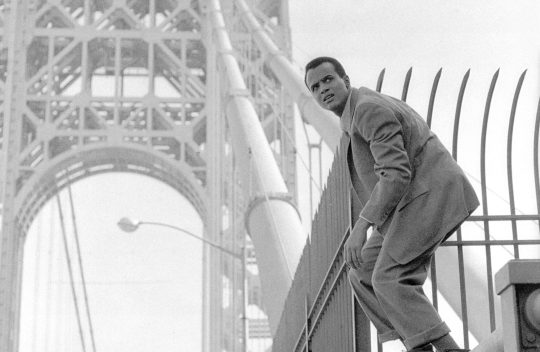
June
La ciociara (1960) directed by Vittorio De Sica with Sophia Loren, Eleonora Brown, Jean-Paul Belmondo, Carlo Ninchi, Andrea Checchi and Pupella Maggio
[First Time]
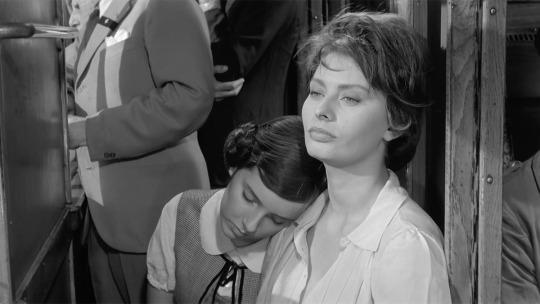
July
Oppenheimer (2023) directed by Christopher Nolan with Cillian Murphy, Robert Downey Jr., Emily Blunt, Matt Damon, Florence Pugh, Josh Hartnett and Casey Affleck
[First Time]

August
Heat (1995) directed by Michael Mann with Al Pacino, Robert De Niro, Val Kilmer, Tom Sizemore, Diane Venora, Amy Brenneman, Dennis Haysbert, Donald Breedan and Ashley Judd
[First Time]

September
Catch Me If You Can (2002) directed by Steven Spielberg with Leonardo DiCaprio, Tom Hanks, Christopher Walken, Nathalie Baye, Amy Adams, Martin Sheen, James Brolin and Brian Howe
[First Time]
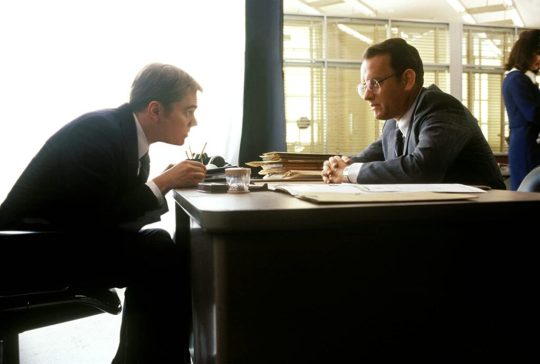
October
Le Grand Bain (2018) directed by Gilles Lellouche with Mathieu Amalric, Guillaume Canet, Benoît Poelvoorde, Jean-Hugues Anglade, Philippe Katerine, Félix Moati, Alban Ivanov, Balasingham Thamilchelvan, Virginie Efira et Leïla Bekhti
[First Time]
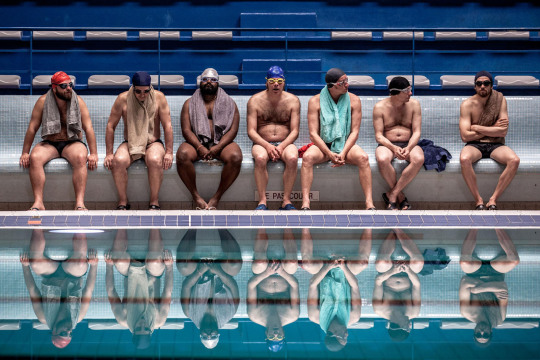
November
Fools Rush In (1997) directed by Andy Tennant with Matthew Perry, Salma Hayek, Jon Tenney, Carlos Gómez, Tomás Milián, Siobhan Fallon et John Bennett Perry
[First Time]

December
The Great Race (1965) directed by Blake Edwards with Tony Curtis, Natalie Wood, Jack Lemmon, Peter Falk, Keenan Wynn et Ross Martin
[First Time]

Honourable Mentions :
Airplane! (1980)
Duel (1972)
Les Sentiments (2003)
The Carpetbaggers (1964)
Scoop (2006)
Mon crime (2023)
To Have and Have Not (1944)
The Super Mario Bros. Movie (2023)
The Man Who Shot Liberty Valance (1962)
臥虎藏龍 (2000)
The Glenn Miller Story (1954)
Le Dernier Voyage (2020)
Dead Men Don't Wear Plaid (1982)
L'ingorgo (1979)
Indiana Jones and the Last Crusade (1989)
Adieu Gary (2008)
Conflict (1945)
Fahrenheit 451 (1966)
La Nuit américaine (1973)
Sorcerer (1977)
La Guerre des polices (1979)
Life of Pi (2012)
The Big Short (2015)
Le Hussard sur le toit (1995)
Excalibur (1981)
The Naked Gun: From the Files of Police Squad! (1988)
Bridget Jones’s Diary (2001)
Le Procès Goldman (2023)
Enter the Dragon (1973)
Matrimonio all'italiana (1964)
Chaplin (1992)
La Vie de château (1966)
Escape from Alcatraz (1979)
Au-delà des grilles (1949)
Second Tour (2023)
Le Couteau dans la plaie (1962)
The Eiger Sanction (1975)
JFK (1991)
Le Fugitif (1993)
Chef (2014)
Quai des Orfèvres (1947)
Appointment with Death (1988)
Bridget Jones: The Edge of Reason (2004)
Wallace & Gromit: The Curse of the Were-Rabbit (2005)
River of No Return (1954)
L'Assassinat du père Noël (1941)
Dances with Wolves (1990)
Die Glasbläserin (2016)
The Lion in Winter (1968)
Les Mystères de Paris (1962)
#2023 films#my top 12#cinema#cinematography#the horse whisperer#l'horloger de saint paul#the fabelmans#the third man#the world the flesh and the devil#la ciociara#oppenheimer#heat#catch me if you can#le grand bain#fools rush in#the great race#films#movies of 2023#bye 2023
13 notes
·
View notes
Text
📰 Revista Almiar, n.º 136 (sept./oct. de 2024) ✍️ Autores publicados: Javier Úbeda Ibáñez · Jorge Cervera Rebullida · Kim Bertran Canut · Gabriel José Vale · Xavier Alejandro Llusá Borges · Jesús Greus · Gretchen Kerr Anderson · Juan Carlos Jurado Reyna · Rocío Soria Romero · José Luis Cubillo Fernández · Norberto Pannone · Luis Méndez Viñolas · Rolando Revagliatti · Natanael Marín Zamudio · Javier Claure Covarrubias · Adán Echeverría García · Carlos Montuenga Barreira · Miy’hon · Nadia Contreras · Carlos Álvarez Orozco · Adriana Tuffo · María Dayana Fraile · Juan Carlos Vásquez · Cecilia Valdez Zúñiga · Alicia Leonor · Rut Treviño · Mia Nallely Amaro Arvizo · Víctor H. Orduña · J. Andrés Tomás Pérez Olvera · Efrén Hernández · Estrella Gracia González · Sunhaila Minelly Sánchez Barrientos · Luis Amézaga · Beatriz Celina Gutiérrez Gómez · Naya Carbonell Garrido 🔗 https://margencero.es/margencero/ 🔗 https://margencero.es/novedades-margencero.htm
#margencero#revistaalmiar#almiar#literatura#revistasliterarias#literatura en español#relatos#narraciones#poesia#poemas#Revista Almiar#Margen Cero#reseña libros#libros#novela#albert camus
2 notes
·
View notes
Note
Who is your favourite OC?
Can you describe them? 🤭♥️
I have a lot but I'll separate them in categories or whatever it is spelled
Bungou Stray Dogs
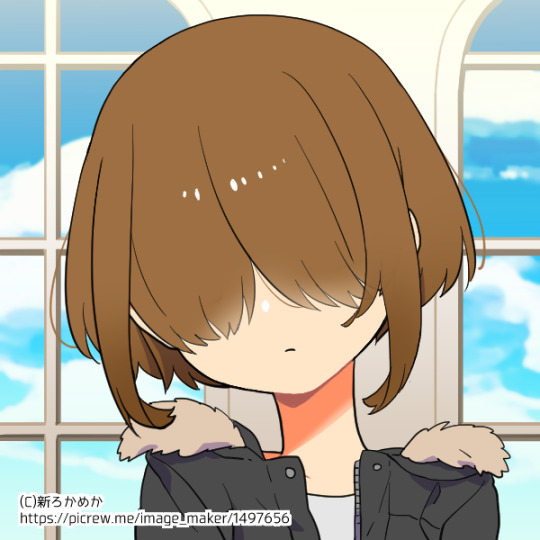
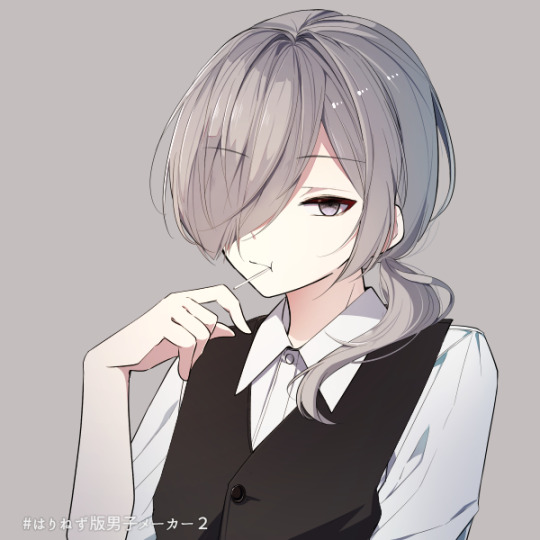
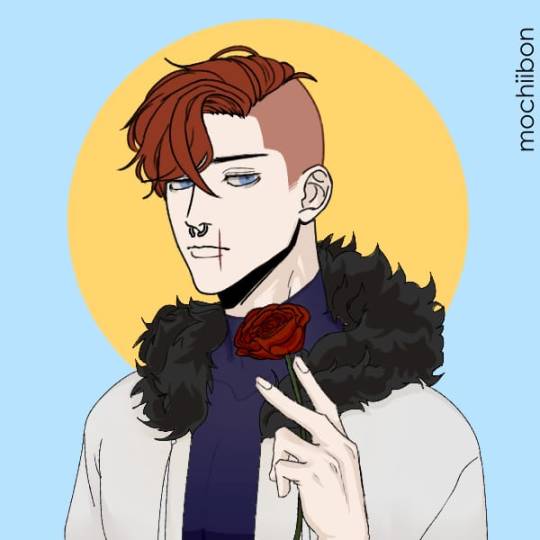
Makoto Dazai
Makoto Dazai is 8 months younger than Osamu Dazai
Being Ougai Mori's bodyguard, Makoto is in the Port Mafia even after what happened with Oda, he has always and will always stay on Mori's side. His ability makes him able to control rats
Makoto is a trans boy, autistic and blind, also Ougai Mori's height. Osamu is obsessed with him in a way that he overprotects his younger brother
Hiroki Maruyama
Covering his right eye because someone took that eye, Hiroki Maruyama is a 28 years old who shares Chuuya's height
Grumpy former trainer in a yakuza, nowadays works in a brothel but in an AU he's a teacher in a school. He's disabled not only because he sees through one eye that makes his life difficult, he has issues walking and is always using a cane
574
2 meters tall man looks scary but is actually extremely soft
Former trainer in a yakuza, now takes care of the daughter of the boss who died. He's a bodyguard, has always been a bodyguard and is in charge of giving the numbers to the people of his (previous) criminal organization
From 0 to 1.000.000, the closest it is to the 0, the stronger the person is with their ability/skill
Bungou Stray Dogs Beast

Gabriel García Márquez
Inspired in the author of the same name, he's from BSD Beast
He owns a restaurant (cat cafe) with his cousin Ángela Vicario and her husband Bayardo San Román. His ability is inspired in the book Chronicle Of A Death Foretold, he's the same age as Hirotsu
M. M.

Max Gómez
Protagonist of the first part of my original story. Max Multiverse
He's a grumpy teenager in that picture, and uh it's hard to explain his world but I hope the multiverse-thing give you an idea
He's 25% a OC self-insert, I started doing his story when I was literally 4 years old lol
Kid is the vessel of a powerful demon, mother abusive, doesn't know his biological dad is the brother of his dad, has an older brother... Max ended up in an asylum after burning his house with his family in, ended up doing a deal with the strongest demon of them all and bla bla bla
B. A. D.

Jack 4
That draw is old as fuck but he's the Jack of universe 4, from the second part of my original story, Black And Demons
Jacks are demons that are the personifications of traumas in humans, the reason why they are traumas rather than the feeling of fear
Jack 4 is in charge of a place called «The Prison/Jail» where powerful and dangerous being are sent so the multiverse won't be destroyed. Oh and his right hand? Oh it's connected to the place he's also locked in and can't scape
BSD OCs inspired in authors excluding Gabriel García Márquez
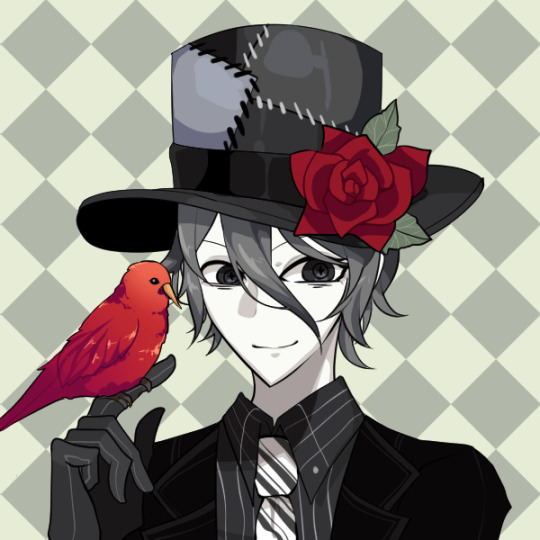
Egon Wolff
He's a homeless person inspired of two characters by Egon Wolff. El Merluza in Paper Flowers and China in The Invaders
Ranpo doesn't trust him and is afraid of him
Obey Me!

Zalgo
He's a demon and the personification of fear, inspired in the creepypasta of the same name, Zalgo
He covers his eyes because when people outside his dimension of chaos stare at him, start crying and shaking in fear extremely traumatized
He gets along with Diavolo, met his dad, Barbatos is his best friend and Lucifer doesn't trust him at all
Jujutsu Kaisen

Kiyoshi Hira
Yes the same picture of my profile picture without the cat ears is a JJK OC
Masamichi Yaga's best friend, Kiyoshi isn't a sorcerer or part of the Jujutsu world because he doesn't get along with the people in charge
Kiyoshi hates Gakuganji, Gojo is afraid of him, Kiyoshi had a wife but died because of Gauganji. Yamato is the name of Kiyoshi's only son
His cursed technique makes him able to control cursed energy just by talking, murmuring and screaming. He can extract cursed energy, absorb it, make it part of other living things, and can communicate with cursed spirits and all of it– Uh he almost destroyed the world one time but can't see in one eye and half of his body is paralyzed because of an accident
#adopted parents council#adopted parents council asks#makoto dazai#kiyoshi hira#jjk ocs#bsd ocs#obey me oc#ocs#b. a. d.#m. m.#real life authors#picrews
8 notes
·
View notes
Text

by Gabriel Gómez Almenzar
204 notes
·
View notes
Text
2024 olympics Chile roster
Archery
Andrés Gallardo (Santiago)
Athletics
Martín Sáenz (Santiago)
Hugo Catrileo (Saavedra)
Carlos Díaz (Santiago)
Claudio Romero (Santiago)
Gabriel Kehr (Temuco)
Humberto Mansilla (Temuco)
Martina Weil (Santiago)
Natalia Duco (San Felipe)
Ivana Gallardo (Osorno)
Canoeing
Paula Gómez (Santiago)
María Mailliard (Viña Del Mar)
Karen Roco (Constitución)
Cycling
Mauricio Molina (Santiago)
Martín Vidaurre (Santiago)
Catalina Soto (Santiago)
Macarena Pérez (Santiago)
Equestrian
Agustín Covarrubias (Santiago)
Fencing
Arantza Inostroza (Santiago)
Golf
Joaquín Niemann (Jupiter, Florida)
Guillermo Pereira (Jupiter, Florida)
Judo
Thomas Briceño (Santiago)
Mary Vargas (Santiago)
Pentathlon
Esteban Bustos (Santiago)
Rowing
César Abaroa (Concepción)
Eber Sanhueza (Puerto Montt)
Antonia Abraham (San Pedro De La Paz)
Melita Abraham (San Pedro De La Paz)
Sailing
Clemente Seguel (Temuco)
María Poncell (Santiago)
Shooting
Diego Parra (Santiago)
Francisca Crovetto (Santiago)
Swimming
Eduardo Cisternas (Santiago)
Kristel Köbrich (Córdoba, Argentina)
Table tennis
Nicolás Burgos (Santiago)
María Vega (Concepción)
Zeng Zhiying (Iquique)
Taekwondo
Joaquín Churchill (Santiago)
Fernanda Aguirre (Santiago)
Tennis
Marcelo Barrios (Santiago)
Nicolás Jarry (La Barnachea)
Alejandro Tabilo (Santiago)
Triathlon
Gaspar Riveros (Providencia)
Diego Moya (Santiago)
Volleyball
Marco Grimalt (Linares)
Esteban Grimalt (Santiago)
Wrestling
Néstor Almanza (Santiago)
Yasmani Acosta (Santiago)
2 notes
·
View notes